Medicinal chemistry - Study guides, Class notes & Summaries
Looking for the best study guides, study notes and summaries about Medicinal chemistry? On this page you'll find 251 study documents about Medicinal chemistry.
Page 4 out of 251 results
Sort by
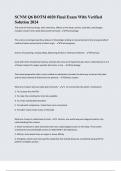
-
SCNM Q6 BOTM 6020 Final Exam With Verified Solution 2024
- Exam (elaborations) • 33 pages • 2024
-
- $11.49
- + learn more
The study of chemical drugs, their chemistry, effects on the body, actions, toxicities, and dosages includes research into newly discovered chemicals - Pharmacology The science encompassing those phases of knowledge relating to natural products that are generally of medicinal value and primarily of plant origin. - Pharmacognosy Science of preparing, compounding, dispensing herbal or chemical medicines. - Pharmacy Used with herbs of potential toxicity, whereby the amount of liquid herb per d...
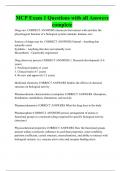
-
MCP Exam 1 Questions with all Answers complete
- Exam (elaborations) • 10 pages • 2023
-
- $11.99
- + learn more
MCP Exam 1 Questions with all Answers complete Drugs are: Sources of drugs may be: Drug discovery process Medicinal chemistry Pharmacokinetic characteristics (examples) Pharmacodynamics Pharmacophore Physicochemical properties Structure Activity Relationship (SAR) studies Isomers Constitutional isomers Stereoisomers Configurational isomers Cis-trans isomers Diastereomers Enantiomers Types of structural isomerism Types of stereoisomerism D-sugar ...

-
Organic Medicinal Chemistry Q&A
- Exam (elaborations) • 18 pages • 2022
-
- $11.99
- + learn more
PACOP REVIEWER (2017) Organic Medicinal Chemistry MULTIPLE CHOICE 1. Decarboxylation of L-dihydroxyphenylalanine produces A. Tyrosine D. Dopamine B. Epinephrine E. Norepinephrine C. Ephedrine ANS: D 2. Drugs with superior lipid solubility usually possess what moiety A. Oxygen D. Sulfur B. Nitrogen E. Fluorine C. Chlorine ANS: D 3. The compound that reacts to salicylic acid to make aspirin is an example of a(n) A. Alcohol D. Acid anhydride B. Ketone E. Ester C. Ether ANS: D 4. T...

-
ORGANIC MEDICINAL CHEMISTRY SUMMARY QUESTIONS AND ANSWERS
- Summary • 609 pages • 2022
-
- $14.99
- + learn more
ORGANIC MEDICINAL CHEMISTRY 1. For numbers 1-5, refer to the structure of a beta-lactam antibiotic The functional group atttached to the acyl amino group is called a/an: A. Phenoxyethyl D. Benzyl B. Isoxazoyl E. Methoxyphenyl C. Imidazole B. Isoxazoyl Ref: Wilson and Gisvold’s Textbook of Organic Medicinal and Pharmaceutical Chemistry, 11th Ed. 2. Halogen substitutes are best placed in what position? A. 1,2-substitution D. Both A and B B. 1,3-substitution E. Both A and ...
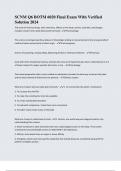
-
SCNM Q6 BOTM 6020 Final Exam With Verified Solution 2024
- Exam (elaborations) • 33 pages • 2024
- Available in package deal
-
- $11.94
- + learn more
The study of chemical drugs, their chemistry, effects on the body, actions, toxicities, and dosages includes research into newly discovered chemicals - Pharmacology The science encompassing those phases of knowledge relating to natural products that are generally of medicinal value and primarily of plant origin. - Pharmacognosy Science of preparing, compounding, dispensing herbal or chemical medicines. - Pharmacy Used with herbs of potential toxicity, whereby the amount of liquid herb per d...
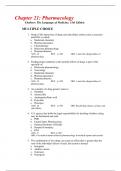
-
Test bank for medical terminology Chapter 21: Pharmacology Chabner: The Language of Medicine, 11th Edition
- Exam (elaborations) • 26 pages • 2023
- Available in package deal
-
- $6.98
- + learn more
TEST BANK FOR MEDICAL TERMINOLOGY SHORTCOURSE 11TH EDITION BY CHABNER Chapter 21: Pharmacology Chabner: The Language of Medicine, 11th Edition MULTIPLE CHOICE 1. Study of the interaction of drugs and subcellular entities such as enzymes and DNA is called: a. Medicinal chemistry b. Pharmacodynamics c. Chemotherapy d. Molecular pharmacology e. Pharmacokinetics ANS: D REF: p. 882 OBJ: Learn the subspecialties of pharmacology. 2. Finding proper antidotes to the harmful effects of ...
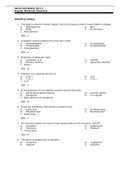
-
Organic Medicinal Chemistry Questions And Answers
- Exam (elaborations) • 19 pages • 2022
-
- $12.99
- + learn more
PACOP REVIEWER (2017) Organic Medicinal Chemistry MULTIPLE CHOICE 1. This agent is used to chelate copper in which an excess amount causes Wilson’s disease A. Deferoxamine D. BAL B. EDTA E. Dimercaprol C. Penicillamine ANS: C 2. A paraben used to preserve the drug from molds A. Metthylparaben D. Butylparaben B. Ethylparaben E. N-butylparaben C. Propylparaben ANS: A 3. Reduction of aldehydes yield A. Carboxylic acid D. Ketones B. Primary alcohols E. Secondary alcohols C. Ethers ...
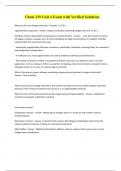
-
Chem 219 Unit 4 Exam with Verified Solutions
- Exam (elaborations) • 15 pages • 2024
-
- $10.09
- + learn more
Chem 219 Unit 4 Exam with Verified Solutions What are the four halogen elements? - Answer -F, Cl, Br, I organohalide compounds - Answer -Organic molecules containing halogen atoms (F, Cl, Br, I) Examples of how organohalide compounds are used by humans - Answer -- have been found in marine life (algae, mollusks, sponges, etc.), bc they metabolize the high concentrations of inorganic chlorides and bromides that are found in the seas. - Industrially, organohalides find uses as solvents, inse...
CAPATI,FLORES,TEODORO,TIGLAO ORGANIC MEDICINAL CHEMISTRY
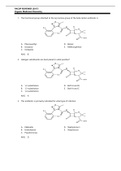
-
PACOP REVIEWER (2017) Organic Medicinal Chemistry Questions and A nswers
- Exam (elaborations) • 60 pages • 2022
-
- $14.99
- + learn more
PACOP REVIEWER (2017) Organic Medicinal Chemistry 1. The functional group attached to the acyl amino group of the beta-lactam antibiotic is A. Phenoxyethyl D. Benzyl B. Isoxazoyl E. Methoxyphenyl C. Imidazole ANS: B 2. Halogen substituents are best placed in what position? A. 1,2-substitution D. Both A and B B. 1,3-substitution E. Both A and C C. 1,4-substitution ANS: A 3. This antibiotic is primarily indicated for what type of infection

Study stress? For sellers on Stuvia, these are actually golden times. KA-CHING! Earn from your study resources too and start uploading now. Discover all about earning on Stuvia



